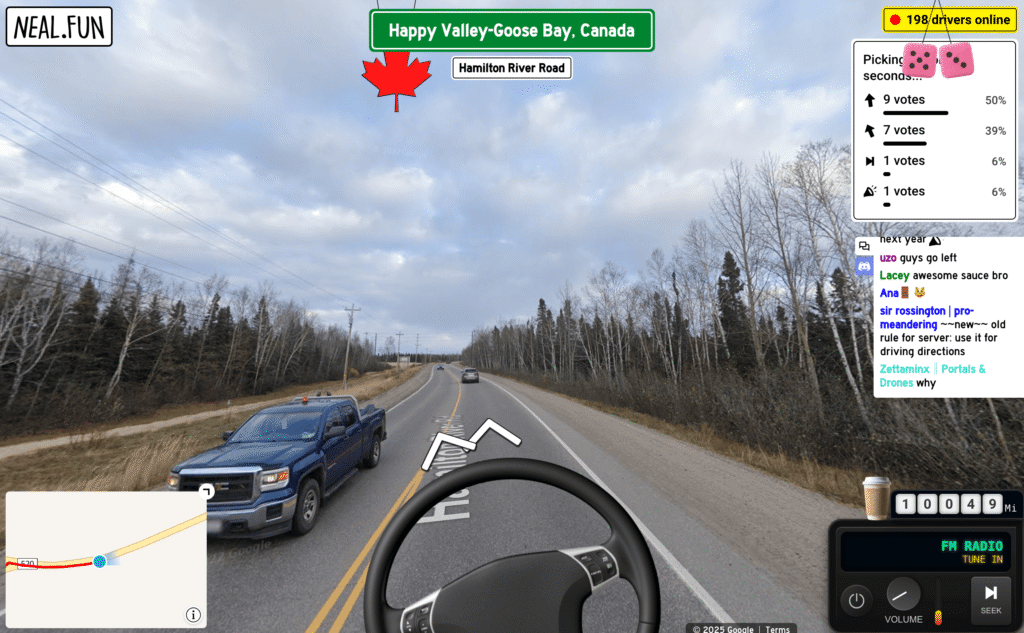We Ride the Plural of Horizon
I created a game that offers a meditative multiplayer experience, where strangers on the internet work together to steer a hot air balloon across the world map. There are no points, no ads, and no reason to play, other than the shared pleasure of drifting somewhere together. It’s called Airtales.fm, and this is the story of how it came to be.
Maps, Simulations, and Elevation Lines
A decade ago, I used to build simulation games. Not the Farmville kind, but slow-burn social experiments where groups could experience simulated situations and environments. One of them was a Google Earth-based experience where you could place future civic projects on real-world terrain. It was naive and idealistic and fun in the way that only city planning with strangers on the internet can be.
Apparently, I never outgrew the habit of turning maps into toys. To this day, I lose hours staring at elevation lines. They’re just little whispers of geography, hinting at how the land moves.
This is a short clip from my 2014 demo reel, giving a glimpse of what those projects were about.
Borders, and the Absence of Calm
I can’t remember ever feeling calm crossing a border.
Maybe it’s the paperwork. Or the implicit judgment. Or the feeling of being reduced to numbers and stamps and visa types.
Leandra, my co-conspirator in life and Airtales, feels weirdly at peace when crossing borders. It’s possibly the only time she’s not anxious. I envy that.
Airtales isn’t a therapy project, but I think it comes from that tension. From the desire to imagine a world you can cross without being interrogated. A world where your direction is shaped not by privilege or paperwork, but by shared intention.
Internet Roadtrips and Open Source Sparks
The first real spark came from Neal Agarwal’s Internet Roadtrip. It was clever and charming and reminded me how much delight there still is in just looking at a map.

That led to a lot of late-night poking around: open APIs, weird WebGL tricks, satellite tiles, and browser hacks. We spent two weeks not building anything, just playing. Like raccoons in a code garage.
Thank god for open source. Without it, this project would’ve taken six months. With it, we built a working prototype in under four weeks.
Built While Floating
We made Airtales while traveling, a new kind of travel for us, pet sitting around the Bay Area. Writing balloon code while playing with dogs and trying to find where the f*ck the cheese shredder went.
At first, I worried about staying productive while constantly moving and swapping kitchens every week. I still have a lot to learn about having a real routine, but weirdly, it worked. I felt just as productive, maybe even more so, than working from home.
We built a game about drifting while actually drifting.


Democracy by Wind
The core mechanic is simple: the crowd votes where the balloon goes.
It’s multiplayer navigation without a driver’s seat. Democracy as drift.
Giving up control can be frustrating. But also kind of beautiful. Especially when strangers align. When east wins by a landslide. Or when everyone agrees to climb.
We added no incentives. No rewards. No FOMO. Just shared direction. That felt like enough.

Stories, Dust, and Radio Signals
Players can tune into real local radio stations as they float, or request a story about the land below.
I spent a whole hour floating around Brazil listening to ‘The Voice of Brazil.’ This is a unique government radio program produced by the country’s public broadcaster. The program must be aired during at 7:00 PM by all Brazilian radio stations every weeknight. It is the oldest radio program in the country and the longest-running in the Southern Hemisphere. I used to hate that, but I was so nostalgic that I couldn’t stop listening to it.
Sometimes, the game responds with a poetic fragment. Like:
“Pollen from fields rises to meet ash from distant suns. We breathe both.”
We wrote dozens of those lines. They appear at random. Like thoughts that float in when you stop scrolling.
The game doesn’t track your location, but it does cross borders. When that happens, it whispers things like:
“Line crossed. No paperwork needed.”


Writing the Story (Then Unwriting It)
I spent a ridiculous amount of time trying to write the perfect narrative arc for Airtales. It went through many phases: at one point it was called Caballoon and had an elaborate mythos about sentient currents guiding the balloon through post-border landscapes. Then it was Airmob, a kind of poetic resistance simulator where players were digital nomads staging soft rebellions with every vote. Then, the Airborn, people who were born in a balloon and don’t understand the concept of borders. Then a cryptic AI whispering through radio static. Then a sci-fi climate story unfolding over time.
None of it felt quite right. Not because they were bad stories (or maybe they were), but because they competed with the space I was trying to build.
So I scrapped it. All of it. In the end, I made something simpler.
Now the story comes from the players. The balloon holds their votes, their messages, their traces. It floats with fragments of everyone who passed through. And that felt more honest than anything I could script. A collective and slow balloon ride wandering through this beautiful world.
Messages in the Basket
I wanted to simulate a kind of real travel that lets you leave traces, not likes, not high scores, just moments. So I added a camera.
Yes, you can take pictures in Airtales. Of a virtual landscape. It sounded silly when I first built it, but I ended up loving it.
Inside the balloon basket, players can leave tiny messages, a photo and a note. These become floating souvenirs. You can even pin them to specific locations on the map. It’s a guestbook that moves with the wind.

The Tech
I could talk about it for days, but let’s keep it brief.
The front end runs on Three.js, which I love. The backend handles vote logic and location updates. We looked into Youtube chat integration, radios database, Discord bots, even livestream overlays. I’m excited about the Twitch API. There are so many interesting things to integrate with your game. This entire game feels like a collaborative livestream.
Some things broke. Some things refused to scale. The balloon doesn’t always float where it should. But it floats.
Because everyone is in the same place geographically, the number of live users doesn’t impact map API usage too much. And we cache tiles in case the balloon loops around, which it often does.
There were some scenarios I hadn’t expected that called for technical changes. For example, when I showed it to some friends, they said they’d love to play this while watching the balloon on a TV in the dentist’s waiting room. Indeed, the whole thing looks like that tvOS screensaver. Another friend said that with some tweaks, it could be one of those TV party games.
Indeed, the game on a TV looks so beautiful.
Why This? Why Now?
Because the world feels a little too divided. And fast. And extractive.
We weren’t trying to fix that. Just offer a different rhythm. One where exploration isn’t gamified, and strangers can co-steer something just for the joy of doing it.
We didn’t build a product. We built a feeling.
The air up here is light.
That’s the whole point.
What’s Next?
Well, I managed to merge all my favorite things into one project: maps, music, stories, and views. Maybe I’ll be the only one playing it, but that’s fine.
This project revived my excitement for game development. It’s a very different energy from building apps. Apps solve things. Games chase joy, reduce boredom, invite play.
We’re already thinking about other games, all real-world map based with touches of activism baked in.
We’re not done drifting yet.
Credits
These are just a few of the people and companies that made this project possible.
- Inspired by Neal Agarwal‘s Internet Road Trip
- Sound effects by freesound_community from Pixabay
- Radio Browser API by Alex Segler
- 3D Model modified from The Getaway by KevinAz61
- GLTF Editor by Andrew Varga
- Rendered by Three.js and stunning libs by Takkram and Su.
- Proofread by Smart Keys for Mac
- Loading Animation by Jon Kantner
- Control Buttons inspired by Prashant
- Elevation API by Open-Meteo
- Geocoding by BigDataCloud
- Google Maps SDK
- TTS by Open AI
- Pair programmed with Windsurf






